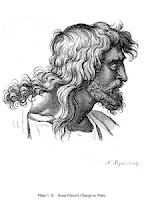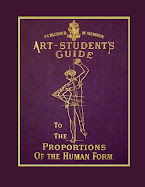The cartoons were completed in 1516, they remained in storage in the Netherlands until 1630 when no other than Peter Paul Rubens made their existence know to Charles I of England who acquired them.
The engravings in this book are the culmination of seven years work. Dorigny already had a reputation as an engraver of Raphael's work from his year in Rome and was encouraged to come to England to produce engravings of the cartoons.Dorigny's plates were presented to King George I of England in 1719.
Benjamin Ralph used the engravings of the heads to produce a work that emphasized their depiction of human expression and first published it in 1759. This republished edition includes images of the cartoons, a new introduction, Benjamin Ralph's commentary, a new bibliography of books mentioned by Benjamin Ralph in his commentary and a new table of contents.
Each plate in the original book shows two heads, and a second plate shows the outline drawing traced from the original cartoons. Because of the large size of the original book, I divided the plates in half and put them on facing pages to reproduce them full scale and show all the detail.
The book also includes the additional plates added to the 1782 edition including proportions of the head, examples of arms, hands, legs and feet and anatomy, and examples of classical statuary.
This is a very rare book, you can only find it in about twenty libraries around the world but now you can purchase an e-book version and get more information at Figure-Drawings.com.
Or you can purchase a paperback version at Amazon.com
Left - The Miraculous Draught of Fishes, Right - Christ's Charge to Peter
Left - The Lame Man Healed, Right- The Death of Ananias
Left - Elymas The Sorcerer Struck with Blindness, Right - Paul and Barnabas at Lystra
St. Paul Preaching in Athens
Additional reading about the cartoons:
Expositions of the cartoons of Raphael
No engravings — although great genius was manifested by Dorigny, and great patience by Holloway—have ever given the full sense of the cartoons. The photographs are, after all, only a literal translation. To form a correct estimate of what the cartoons of Raphael are—to feel fully their power—they must be seen for themselves; and just as we find that the Bible reveals most of the word of God to us, when it is the first book in the day that we read, so the cartoons will only manifest themselves to those who have steadily refused to look at a single picture, as they passed through the various rooms, and have brought to the gallery a virgin eye.
Analysis of the cartoons of Raphael
The epochs of painting characterized
Curious questions in history, literature, art, and social life ..., Volume 2 By Sarah Hutchins Killikelly at Google Books
Raphael: his life, works and time
Notes on the cartoons of Raphael now in the South Kensington Museum
The Literary world, Volume 10 at Google Books
The life of Raphael By Herman Friedrich Grimm, Sarah Holland Adams at Google Books
The majority of these Cartoons had long remained in the Netherlands, but in 1630, through the mediation of Rubens, they were sold to England, where they were regarded as Raphael's most valuable creations. After the beheading of Charles I., scarcely any of Raphael's pictures were to be found in England. We know for what inconceivably small prices they had been sold to France ; but the Cartoons for the Tapestries seem to have been regarded even by the Puritans as a precious possession. Dorigny was summoned to engrave them. A national subscription covered the cost. Dorigny worked on them from 1711-'19, and his success was wonderful. His energy, as well as his execution, was unrivalled, and we may truly say to-day, regarding the conception of these works, that they presented Raphael from a new side, a side which, so far as we know, had not before been visible to anybody.
The stranger's guide to Hampton Court palace and gardens
The Literary gazette: A weekly journal of literature, science, and ..., Volume 3 By George Augustus Frederick Fitzclarence (1st Earl of Munster) at Google Books
These plates were begun in the reign of Queen Anne. Certain English gentlemen then at Home, where Dorigny was studying, struck with the merit of a plate which he had engraved from the transfiguration of Raphael, and wishing to patronize so ingenious an artist, on their return prevailed on several persons of rank to invite him to England, to engrave the Cartoons at Hampten Court. Dorigny obeyed the summons, and arrived in June 1711.
It was expected that the government would have employed him, and that the plates should remain ihe property of the crown, to furnish sets of the engravings for presents to foreign princes and their ambassadors ; but the sum demanded by the engraver, four or five thousand pounds, being considered by the parliament too much of tbe public money to appropriate for such a purpose, although the Lord Treasurer Oxford was his friend, and the Queen his patron, that design was frustrated, and Dorigny opened a public subscription of four guineas for the set of eight large plates, including a title-page, by which, and the assistance of private patronage, he was enabled to complete his meritorious work.
All the drawings and studies from the originals were made by Dorigny; but finding the engraving would be too arduous a labour for his own hand, he engaged two assistants, Charles Dupuis and Claude Dubosc. These artists disagreeing with him, when the plates were advanced only half-way, left Dorigny to finish them alone. Dubosc, not satisfied with exposing him to this inconvenience, basely attempted to injure his employer, by offering to execute a set of engravings from these subjects, for the print-sellers; but failed in his object.
Queen Anne, kindly commiserating his embarrassment, encouraged the ingenious foreigner to proceed, by many acts of personal condescension, frequently honouring him with a visit, and expressing her admiration of his work. Unhappily for Dorigny, the Queen died, and he had to seek another royal patron.
The Saturday magazine, Volume 22 at Google Books
First Engravings From Raphaei's Cartoons.
Dorigny, a Frenchman by birth, who had spent ten years in endeavouring to emulate the vigour and grandeur of Audran's style of engraving, came to England in 1711, with the design of engraving the Cartoons of Raphael. After many difficulties, he had apartments assigned to him, by the Queen, in Hampton Court Palace, and he commenced his work by public subscription, at four guineas the set. The labour of seven plates, of the large dimensions resolved on, seemed too much for one individual, and accordingly we find Dorigny seeking assistance from France. Dupuis and Dubosc were the names of the artists who came from Paris to lend hiin the necessary assistance, but both these artists left him before the expiration of the first three years.
On the 1st of April, 1719, after Dorigny had been employed for seven years in his work, he had the gratification of presenting two complete sets of these celebrated engravings (witli a dedication) to George the First. He also gave one set to the Prince and another to the Princess. The present was acknowledged by a gift from the King of a purse containing one hundred guineas, and from the Prince of a medal; while the Duke of Devonshire, from whom the artist had borrowed four hundred pounds, freely remitted the interest for four years. These engravings extended the reputation of Dorigny throughout Europe, and in the succeeding year he received the honour of knighthood from the hands of the King.
Dorigny had begun to study drawing and engraving rather late in life, and he must have been about fifty years of age when he commenced the engravings from the cartoons. It is therefore the more surprising that so considerable a degree of success should have attended his labours. In this light it has been remarked that the power he acquired in the use of the graver was extraordinary. " The art with which he mingled the lines of the graver with those of the etching-needle is also much to be admired; and though it must be allowed that in copying Raffaelle's forms he has often lost much of their exquisite grace and chasteness, and has rendered the character of his heads but coarsely, yet on the whole he rides his graphic Pegasus with masculine grace. There is a manly energy and freedom in his style, bridled by simplicity; his shadows are full-toned, clear, and rich, and though his flesh be deficient in characteristic texture, the lines are often conducted over his draperies with unprecedented freedom and elegance, of which the figure of 'St. Paul preaching at Athens,' and that of the same Apostle in the cartoon of ' Elymas the Sorcerer struck blind,' may be sufficient examples."
While Dorigny was making his drawings of the cartoons a person in London offered him two hundred pounds for them; but the artist refused to make any agreement until all the plates should be completed. These drawings were afterwards sold at his auction for fifty-two guineas, and the total amount of his drawings realized three hundred and twenty pounds.

































No comments:
Post a Comment